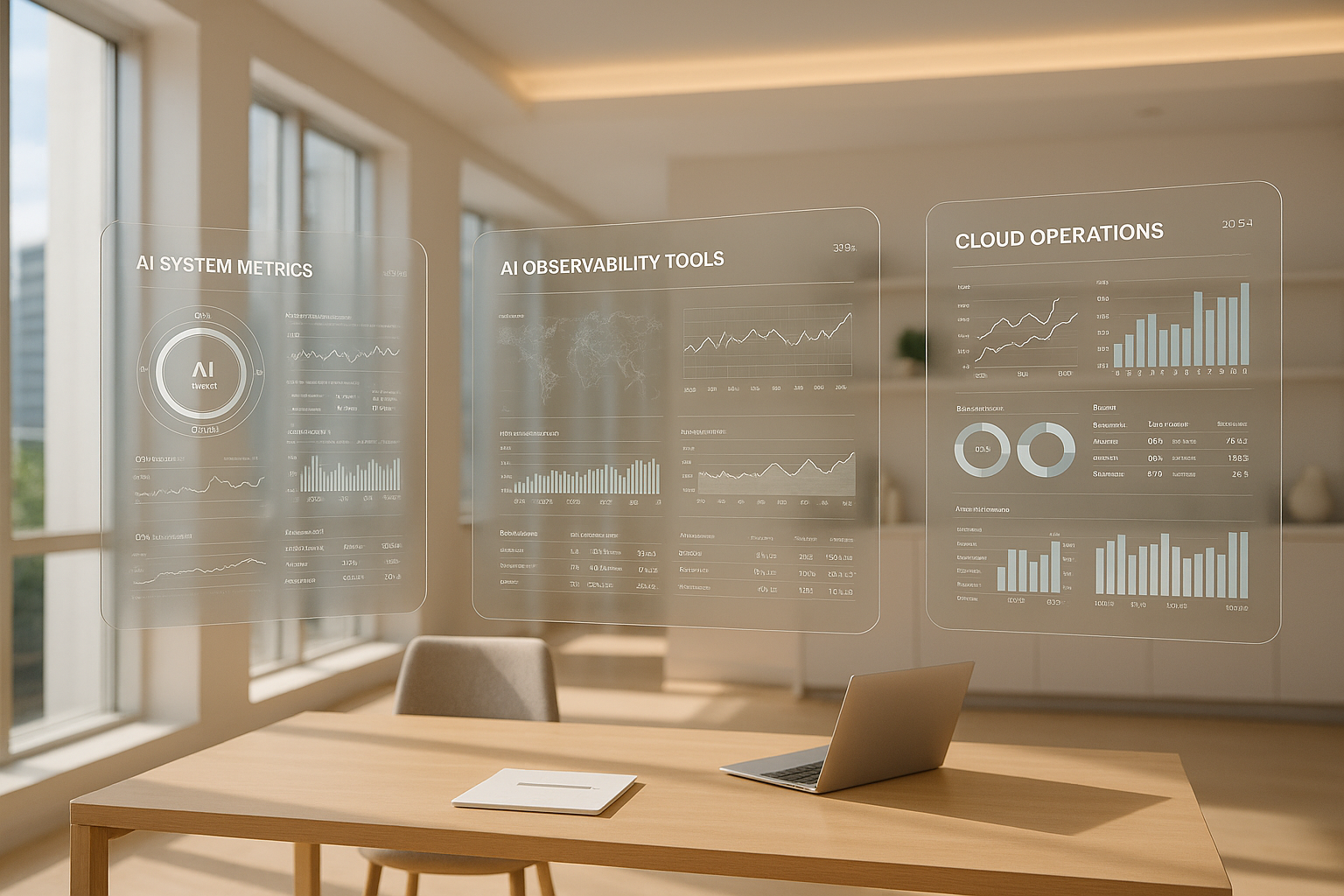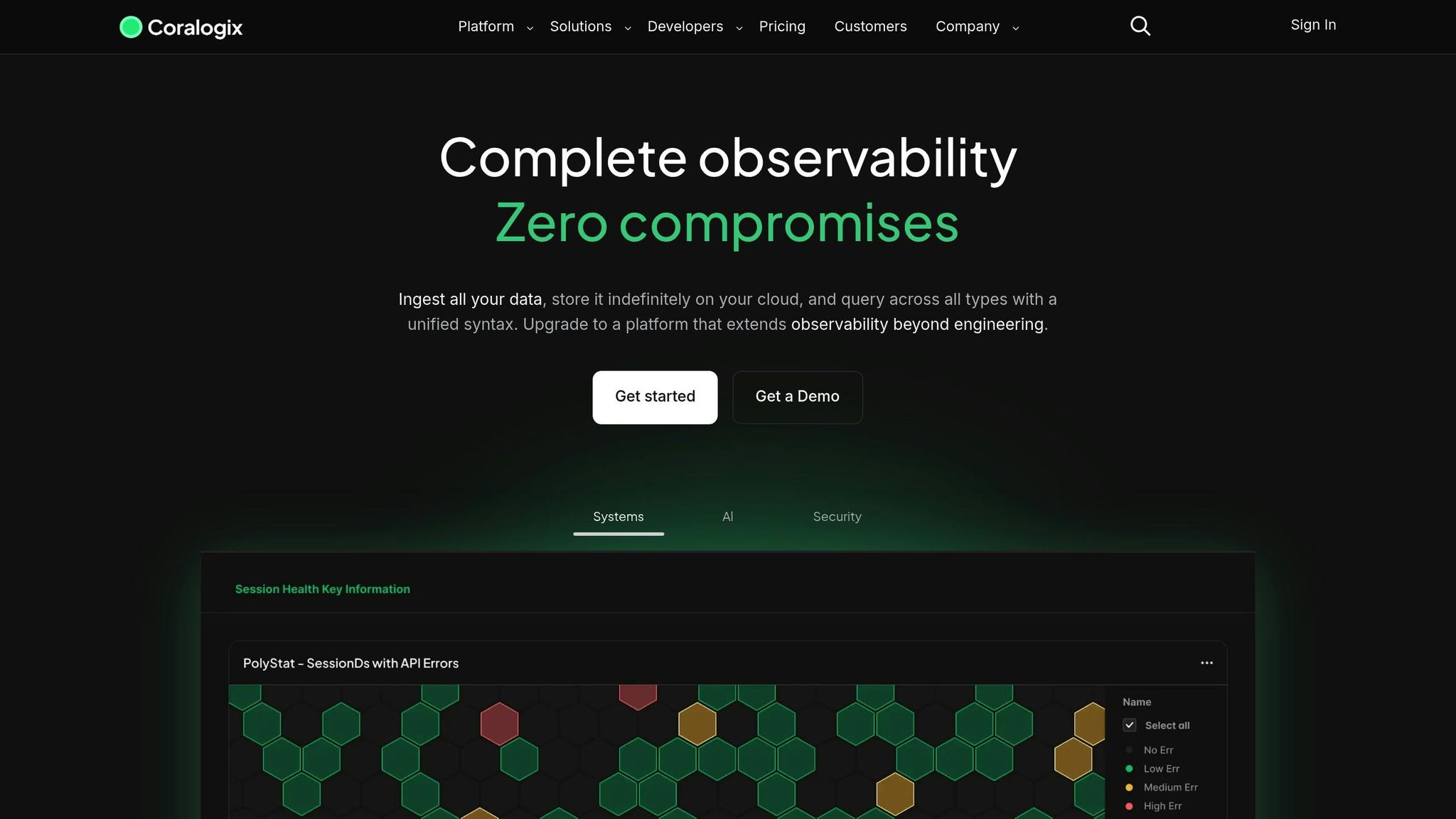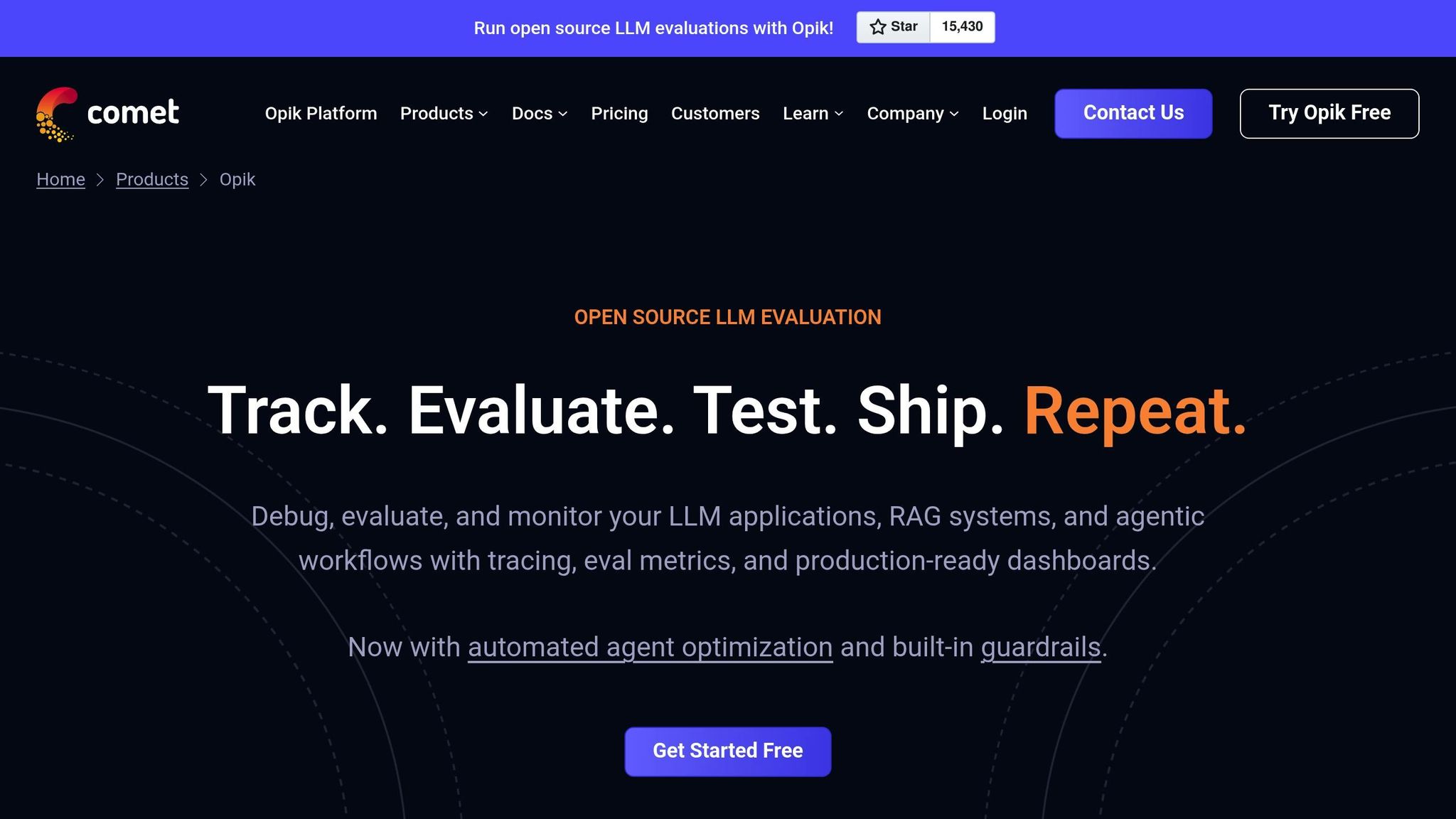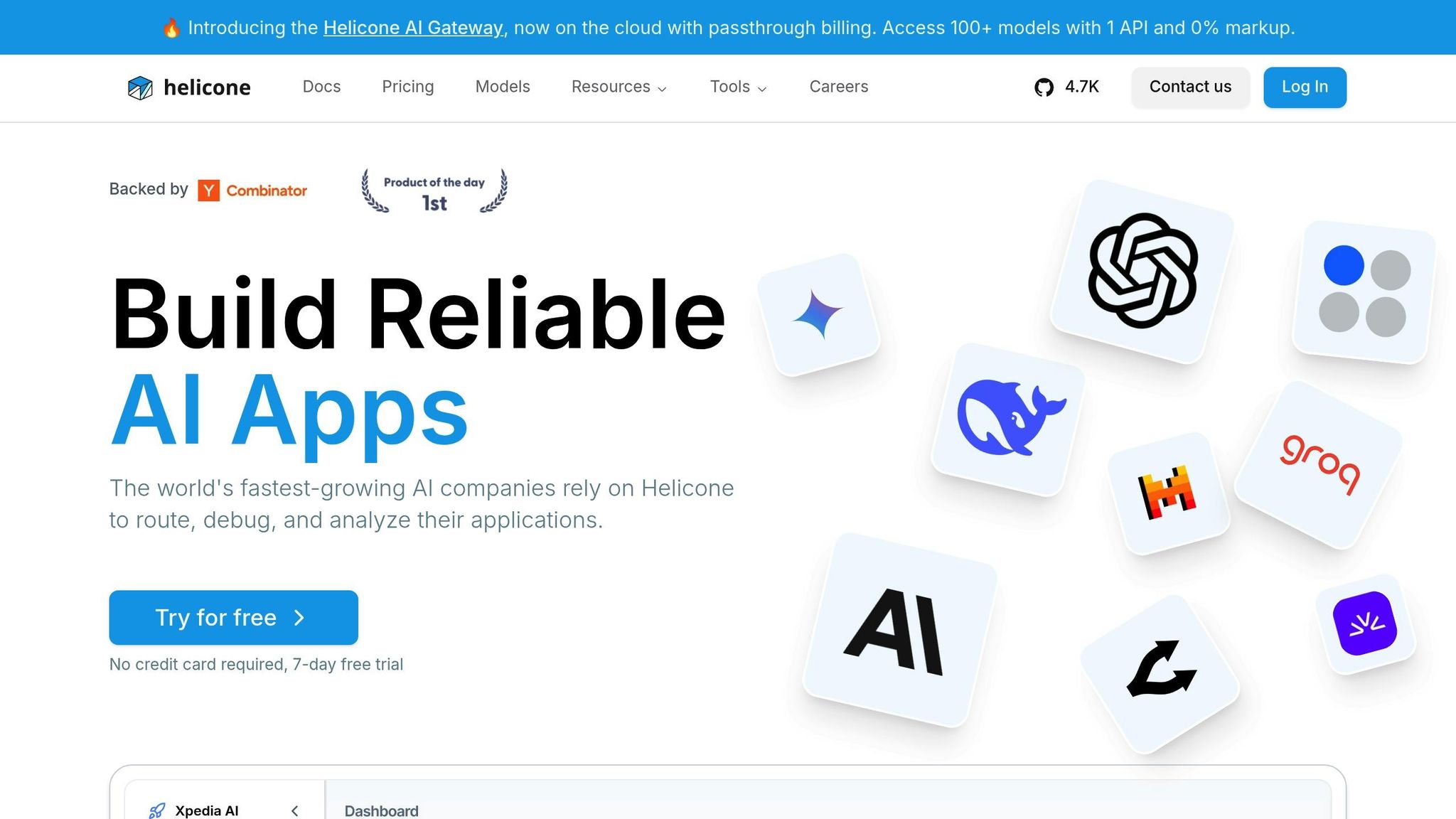
AI observability is the process of monitoring and understanding AI systems in production to ensure they operate effectively, securely, and cost-efficiently. The best tools in 2025 focus on real-time monitoring, security, and cost management for cloud-native AI deployments. Here's a quick overview of the top five tools:
Each tool addresses unique needs, from managing costs to ensuring security and compliance. Below is a comparison to help you choose the right one for your organization.

Coralogix brings a sharp focus to the performance, security, and cost clarity of scalable, cloud-native AI systems. With Coralogix AI Observability, you get real-time insights into how AI systems are performing, uncover security threats, and manage operational costs effectively. The platform excels at providing detailed tracing and analytics for AI applications, tracking key metrics like errors, token usage, costs, and response times - all without disrupting user experiences in generative AI environments.
Coralogix offers instant visibility into AI operations through specialized dashboards. These dashboards highlight critical metrics like latency, error rates, and token consumption across different models and applications. This allows teams to spot performance trends and address bottlenecks before they impact users. On top of that, the platform’s risk assessment and metadata tracking tools pinpoint abusive behaviors and potential data leaks, giving security teams actionable insights.
One standout feature is its ability to scan GitHub repositories to identify where generative AI is being used within an organization. This helps security teams maintain control and minimize risks tied to AI deployments. The platform’s real-time visibility works seamlessly across various deployment environments, ensuring comprehensive oversight.
Coralogix is designed to integrate effortlessly into modern infrastructures. It works seamlessly with OpenTelemetry, supporting a wide range of environments, whether cloud-native or hybrid. Whether your AI systems run on AWS, Azure, Google Cloud, or on-premises setups, Coralogix can handle Kubernetes deployments, serverless architectures, and leading AI/ML frameworks. This flexibility makes it ideal for organizations managing distributed AI workloads in diverse environments.
Beyond monitoring and analytics, Coralogix strengthens AI deployments with advanced security measures. Its AI Security Posture Management (AI-SPM) keeps an eye on prompt injections, suspicious activities, and unexpected cost spikes. A library of specialized evaluators is available to detect issues like prompt injection, hallucination, and toxicity. With a simple one-click setup, teams can quickly deploy these threat detection tools. Security dashboards provide immediate insights into potential risks, helping teams respond swiftly to threats across their AI infrastructure.
Coralogix simplifies cost management by centralizing usage analytics. Teams can easily spot high-cost users and potential abuse by tracking resource consumption, API calls, and model inference expenses. The platform offers tools like budget alerts, detailed usage breakdowns by team or project, and forecasting features. This helps organizations keep spending under control and avoid surprise charges, ensuring financial oversight for large-scale AI operations.

New Relic's Intelligent Observability Platform offers a robust solution for enterprises managing and scaling AI systems. It combines real-time monitoring, anomaly detection, and automated root cause analysis to support both complex and autonomous AI systems. What sets New Relic apart is its natural language interface and integration with GitHub Copilot, making it easier for both technical and non-technical users to evaluate code and monitor systems effectively. This design bridges the gap between advanced monitoring tools and accessibility for business users.
With machine learning–powered anomaly detection, New Relic identifies issues like token usage spikes, API latency problems, and system bottlenecks as they happen. Its dashboards are fully customizable, letting teams track vital metrics such as inference times, resource usage, and overall model performance - all in one view.
One standout feature is its natural language querying capability, which translates plain English into NRQL (New Relic Query Language). This allows business users to generate custom dashboards and dive into AI pipeline performance without needing coding skills or IT support. Teams can monitor model performance, latency, and error rates, while benefiting from drill-down analysis and instant alerts.
Additionally, New Relic integrates with GitHub Copilot, enabling teams to assess code changes before deployment. This proactive step helps catch potential issues early, reducing the risk of disruptions in production AI systems.
New Relic shines in its ability to support diverse deployment environments. Whether your AI models run in cloud-native or hybrid setups, the platform integrates seamlessly with major cloud providers like AWS, Azure, and Google Cloud. It uses agent-based instrumentation and API integrations to ensure consistent monitoring, whether systems are in the cloud, on-premises, or in mixed environments.
This versatility extends to containerized deployments, serverless architectures, and traditional infrastructures. Organizations can monitor distributed AI workloads without worrying about compatibility gaps or missing visibility, making it a reliable choice for varied infrastructure setups.
For industries where security and compliance are critical, New Relic offers a comprehensive set of features. These include role-based access control, data encryption (both in transit and at rest), and detailed audit logging. These tools help organizations meet regulatory standards such as GDPR and HIPAA while ensuring sensitive AI data remains secure.
The platform also provides automated compliance reporting and integrates with enterprise identity providers. This enables teams to track data access and maintain the audit trails needed for industries like healthcare and finance, where governance is a top priority.
New Relic includes advanced cost management tools to help organizations keep track of resource usage and spending for AI models. Users can set budget alerts in US dollars, analyze spending patterns, and allocate costs by project or team. This level of detail is crucial for controlling expenses in large-scale AI deployments, where costs can quickly spiral out of control.
The platform's business observability features, such as Pathpoint Plus, connect IT metrics with business outcomes. By linking technical performance to KPIs like revenue and customer satisfaction, teams gain a clearer understanding of how their AI systems impact broader business goals. This insight ensures organizations can align their technical efforts with measurable results.

Arize Phoenix builds on established machine learning monitoring practices to offer a solid solution for LLM observability. Instead of starting from scratch, it has evolved to meet the demands of modern AI systems. Its strengths lie in advanced embedding drift detection and monitoring retrieval-augmented generation (RAG) pipelines, capturing nuanced semantic changes that traditional metrics often overlook.
Phoenix takes real-time monitoring to the next level with customizable dashboards designed to track essential metrics like embedding drift scores, retriever performance, and content relevance. These dashboards provide instant alerts for anomalies, giving teams the tools they need to investigate and resolve issues quickly.
For RAG-based applications, Phoenix includes tools tailored to analyze retriever performance and monitor content relevance. These features help teams identify and address knowledge gaps in their retrieval systems efficiently.
Phoenix is designed for flexibility, integrating seamlessly using OpenTelemetry instrumentation. It supports popular frameworks like LlamaIndex, LangChain, and DSPy, making it easier for organizations to get started. This compatibility ensures consistent observability across various infrastructures, saving time during onboarding and simplifying deployment.
To meet the needs of regulated industries, Phoenix incorporates enterprise-grade security measures. These include role-based access control, data encryption (both in transit and at rest), and audit logging. These features help organizations adhere to standards such as HIPAA, GDPR, and CCPA, ensuring compliance while maintaining a secure environment for data and operations.
Phoenix provides detailed cost tracking by model, project, or team, offering a clear picture of budget allocation in US dollars. Automated reports and budget alerts make it easy to monitor spending, helping organizations avoid overspending while ensuring resources are used effectively. This dual focus on technical performance and financial oversight offers a balanced approach to managing AI infrastructure.

Comet Opik is an AI observability platform designed to monitor large language models and AI agents. Built on an open-source foundation, it offers two deployment options: self-hosted for organizations needing full control over their data and managed cloud services for those looking to simplify operations. The platform focuses on agent-specific monitoring, providing a clear view of multi-step reasoning and tool usage that goes beyond basic metrics. By exposing the inner workings of AI agents, Comet Opik makes it easier to understand and troubleshoot complex workflows. Let’s dive into how it handles monitoring, deployment, security, and cost management for advanced AI systems.
Comet Opik provides real-time monitoring through intuitive dashboards that reveal agent behavior, multi-step reasoning, and tool usage patterns. These dashboards display live model outputs, error rates, and bottlenecks, offering valuable insights for both development and production teams. This transparency allows developers to quickly pinpoint and resolve issues, ensuring smooth interactions before they affect end users. These monitoring features set the stage for its flexible deployment options, discussed next.
The platform supports managed cloud and self-hosted deployments, making it compatible with public cloud environments, on-premises data centers, and hybrid setups. It integrates seamlessly with popular frameworks like OpenAI, LangChain, LlamaIndex, and DSPy, enabling observability across various AI ecosystems without disrupting existing workflows.
Security is a key priority for Comet Opik. Its open-source nature allows teams to self-host, ensuring complete control over sensitive data - a crucial advantage for organizations bound by strict security or regulatory requirements. Enterprise features such as role-based access controls, audit logs, and integration with existing security tools help meet compliance standards. The self-hosting option is especially beneficial for organizations concerned about data sovereignty or vendor lock-in, as it provides full ownership of observability data and compliance with data residency regulations.
Comet Opik includes advanced cost tracking and usage analytics, giving teams the ability to monitor resource consumption, track API usage, and allocate expenses across projects or departments. These detailed insights go beyond basic metrics, offering a granular view that helps align AI spending with business goals. This level of cost management ensures that resources are used efficiently while supporting effective scaling.

Helicone takes a proxy-based approach to monitor large language model (LLM) usage by redirecting API endpoints, allowing for quick setup without altering existing code. It provides unified monitoring across various LLM providers like OpenAI, Anthropic, and Google Gemini, offering a broad view of AI activity. This tool builds on earlier discussions about observability, focusing on easy deployment and support for multiple providers.
Helicone offers real-time insights into AI model performance through dashboards that you can customize to suit your needs. You can track key metrics like latency, error rates, token usage, and prompt response times. These dashboards allow you to compare performance and costs across different LLM providers in real time.
Helicone works seamlessly with major cloud platforms such as AWS, Azure, and Google Cloud. It also supports Kubernetes, making it suitable for both public cloud and on-premises setups. This flexibility ensures it can adapt to various deployment scenarios.
Security is a priority for Helicone, which includes features like role-based access control (RBAC), encryption (both in transit and at rest), and audit logging. These measures help meet compliance requirements such as SOC 2 Type 2 and GDPR. Additionally, dashboards are tailored for U.S. businesses, displaying costs in U.S. dollars and using the MM/DD/YYYY date format.
Helicone stands out in cost management by providing real-time tracking of API usage, token consumption, and expenses. Its dashboards break down costs by model, endpoint, or user, offering detailed insights. Virtual API keys allow for precise attribution, and you can set up custom alerts for usage thresholds, cost limits, or performance metrics. Notifications can be sent via email, Slack, or other integrated platforms.
The table below outlines the main differences between the tools discussed earlier. Choosing the right observability tool depends on your organization's needs for monitoring, security, and budget. Each platform is tailored for specific operational environments.
The tools vary significantly in their monitoring capabilities. Coralogix AI Observability provides instant insights into user activities, helping identify high-cost users or potential misuse scenarios. New Relic uses machine learning to flag irregularities in LLM token usage and API latency. Arize Phoenix specializes in advanced drift detection with automated alerts, while Comet Opik focuses on agent-centric monitoring. Meanwhile, Helicone employs a proxy-based system for real-time monitoring and detailed cost tracking by model.
Cloud compatibility also differs depending on deployment needs. New Relic is designed for hybrid cloud setups and enterprises scaling generative AI, though it may require some initial configuration for teams without an existing toolchain. Helicone supports multi-cloud environments and Kubernetes, while both Arize Phoenix and Comet Opik offer cloud-native solutions, with the latter also supporting self-hosted deployments.
Security features range from basic compliance to advanced threat detection. Coralogix AI stands out with its AI Security Posture Management (AI-SPM) dashboard, providing deep insights into issues like prompt injections, suspicious user behavior, and cost-harvesting risks. It can also scan GitHub repositories to identify where generative AI is being used, reducing security vulnerabilities. New Relic integrates with GitHub Copilot to analyze code changes before deployment, minimizing risks.
Integration capabilities impact ease of use. New Relic allows non-technical users to create dashboards with natural language queries, while Helicone requires no code changes thanks to its proxy-based setup. Comet Opik integrates seamlessly with CI/CD pipelines, enhancing deployment workflows.
Cost management approaches vary as well. Coralogix AI provides real-time dashboards to monitor token usage and costs, making it easier to spot high-cost users or misuse. New Relic uses machine learning to detect usage anomalies, and Helicone offers detailed cost insights with customizable alerts.
Here’s a quick comparison chart summarizing the core features, cloud compatibility, security, integration, and cost management for each tool:
| Tool | Real-Time Monitoring | Cloud Compatibility | Security Features | Integration Options | Cost Management |
|---|---|---|---|---|---|
| Coralogix AI | User activity tracking, misuse detection | Cloud-native | AI-SPM dashboard, GitHub scanning | OpenTelemetry, custom evaluators | Usage and cost tracking |
| New Relic | Machine learning for anomaly detection | Hybrid cloud | GitHub Copilot integration | Natural language queries, GitHub, AWS | Business observability |
| Arize Phoenix | Drift detection, RAG monitoring | Cloud-native | Advanced drift alerts | OpenTelemetry, LlamaIndex, LangChain | Cost attribution |
| Comet Opik | Agent workflow visualization | Cloud & self-hosted | Open-source transparency | CI/CD pipelines, OpenAI, LangChain | Enterprise-level cost features |
| Helicone | Proxy-based real-time monitoring | Multi-cloud, Kubernetes | RBAC, encryption, audit logs | API endpoint swap, virtual API keys | Real-time cost breakdown by model |
Coralogix AI also includes an AI Evaluator Catalog with specialized evaluators for prompt injection, hallucination, and toxicity detection. These evaluators are easy to set up, offering a single-click configuration for security teams.
When selecting a tool, consider how well it integrates with your existing systems and whether it meets your security and monitoring requirements.
Selecting the right AI observability tool hinges on three key factors: scalability, real-time monitoring, and cloud-native compatibility. Each of these elements plays a vital role in ensuring smooth and reliable AI operations.
Scalability is essential for handling growing data volumes and increasing model complexity, particularly for industries like finance and healthcare in the U.S. While most tools offer scalable solutions, they differ in how they approach deployment and manage resources efficiently.
Real-time monitoring is critical for identifying anomalies and security threats as they happen, minimizing downtime. For instance, a U.S.-based healthcare provider using New Relic's platform can monitor LLM-powered chatbots for unusual response times or unauthorized data access. If a latency spike or a potential data breach is detected, the system sends alerts, enabling IT teams to address issues before they disrupt patient care.
Cloud-native compatibility ensures seamless integration with major cloud providers like AWS, Azure, and Google Cloud. This is especially important for U.S. organizations that rely on hybrid and multi-cloud setups. Such integration supports consistent monitoring across distributed environments while leveraging cloud features like automated scaling and built-in security.
Modern observability platforms provide comprehensive visibility by tracing interactions, identifying anomalies, and assessing risks. Features such as span-level tracing, AI security posture management, and automated risk assessments help organizations protect data, meet compliance standards, and mitigate potential threats. Additionally, intuitive dashboards bridge the gap between technical and business teams, linking metrics to KPIs. This alignment fosters collaboration, enabling teams to monitor AI performance, evaluate business impact, and make informed decisions that enhance efficiency and strategic outcomes.
When implementing these tools, U.S. organizations should focus on platforms that meet regulatory standards like SOC 2 Type 2 and HIPAA compliance. Features like robust audit logging and granular access controls are also essential. Solutions that support OpenTelemetry and scalable architectures can address challenges related to integration complexity and data privacy laws.
For enterprises building custom AI solutions, collaborating with experts like Artech Digital can be invaluable. Their services, including custom AI agent development and model fine-tuning, enhance observability while ensuring effective AI lifecycle management and monitoring capabilities.
When choosing an AI observability tool for cloud-native environments, it’s important to prioritize core features, scalability, and smooth integration with cloud-native systems. The tool should align with your existing infrastructure while offering real-time monitoring, in-depth analytics, and effective troubleshooting capabilities.
Artech Digital delivers specialized AI solutions, such as AI-driven web applications, custom AI agents, advanced chatbots, computer vision tools, and fine-tuning of large language models (LLMs). These services are designed to ensure your AI systems operate at their best in cloud-native environments.
AI observability tools are essential for keeping AI systems secure and ensuring they comply with regulations like GDPR and HIPAA. These tools actively track data usage, monitor system behavior, and detect potential vulnerabilities as they arise, enabling quick action to mitigate risks before they grow into larger issues.
With features like detailed audit trails, encryption monitoring, and robust access controls, these tools help organizations protect sensitive data and maintain transparency. This not only ensures adherence to strict data protection laws but also strengthens confidence in AI-powered technologies.
Proxy-based setups bring a range of benefits when it comes to managing AI systems, especially in areas like real-time monitoring and keeping costs in check. Acting as a middle layer between your AI models and their users, these setups allow you to monitor requests, responses, and performance metrics without needing to alter the core infrastructure.
This setup offers clearer insights into how the system operates, making it easier to spot bottlenecks or areas where performance could improve. On top of that, proxy-based setups help with tracking expenses, offering detailed data on resource usage. This level of detail simplifies budget allocation and helps fine-tune spending.

.png)
